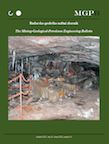A software sensor for in-situ monitoring of the 5-day biochemical oxygen demand
DOI:
https://doi.org/10.17794/rgn.2018.1.3Abstract
Due to the time-consuming procedure for determining the 5-day biochemical oxygen demand (BOD5), the present study developed two software sensors based on artificial intelligence techniques to estimate this indicator instantaneously. For this purpose, feed-forward and radial basis function neural networks (FFANN and RBFANN, respectively) were tuned to estimate the maximum values of BOD5 (BOD5(max)) as a function of average, maximum and minimum dissolved oxygen in the Sefidrood River. Also, Levenberg-Marquardt (LM), resilient back propagation (RP), and scaled conjugate gradient (SCG) algorithms were used to optimize the FFANN parameters. The results demonstrated that the performance of LM algorithm in tuning the FFANN was better than others, in verification step. Besides, the performance of both FFANN and RBFANN models for prediction of the BOD5(max) was approximately the same.
Downloads
Published
How to Cite
Issue
Section
License
Copyright (c) 2017 Rudarsko-geološko-naftni zbornik

This work is licensed under a Creative Commons Attribution 4.0 International License.
Creative Commons-BY
Authors who publish with this journal agree to the following terms:
In agreeing this form, you certify that:
- You read the ethical codex of the RGN zbornik available at journal web.
- You submitted work is your original work, and has not previously been published and does not include any form of plagiarism.
- You own copyright in the submitted work, and are therefore permitted to assign the licence to publish to RGN zbornik.
- Your submitted work contains no violation of any existing copyright or other third party right or any material of an obscene, libellous or otherwise unlawful nature.
- You have obtained permission for and acknowledged the source of any illustrations, diagrams or other material included in the work of which you are not the copyright owner.
- You have taken due care to ensure the accuracy of the work, and that, to the best of your knowledge, there are no false statements made within it.
- All co-authors of this submitted work are aware of, and in agreement with, the terms of this licence and that the submitted manuscript has been approved by these authors.
Publication licence
You retain copyright in your submitted work, according to journal license policy (CC-BY). By signing this form you agree that RGN zbornik may publish it under the publication licence. In summary the licence allows the following:
Anyone is free:
- To copy, distribute, display, and perform the work.
- To make derivative works.
Under the following conditions:
- The original author must always be given credit.
- The work may not be used for commercial purposes.
- If the work is altered, transformed, or built upon, the resulting work may only be distributed under a licence identical to this one.
Exceptions to the licence
In addition to publishing the work printed under the above licence, RGN zbornik will also enable the work to be visible online.
The journal editorial can change the licence rules anytime but it cannot retroactively restrict author(s) rights.


